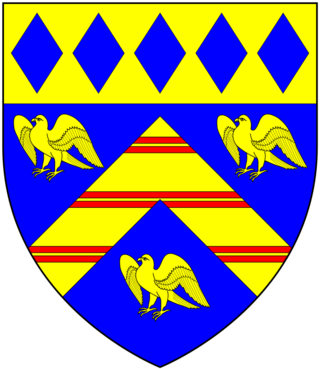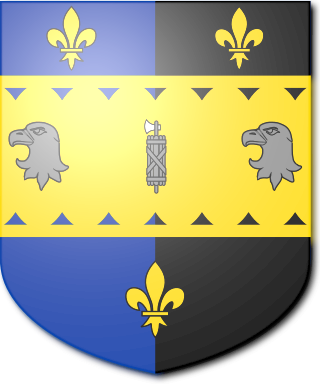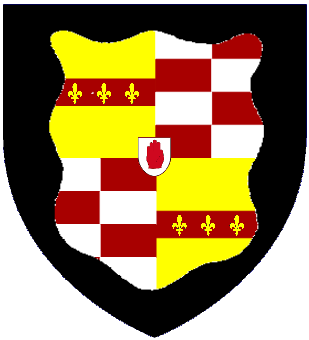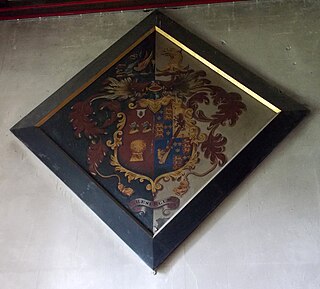
Baron Roborough, of Maristow in the County of Devon, is a title in the Peerage of the United Kingdom. It was created on 24 January 1938 for Sir Henry Lopes, 4th Baronet. He had earlier represented Grantham, Lincolnshire, in Parliament as a Conservative. The Baronetcy, of Maristow House in the County of Devon, had been created in the Baronetage of the United Kingdom on 1 November 1805 for Manasseh Masseh Lopes, a member of a wealthy family of Portuguese Jewish origin, with special remainder to his nephew Ralph Franco, son of his sister Maria. Manasseh Masseh Lopes converted to Christianity in 1802, and later represented Evesham, in Worcestershire, Barnstaple in Devon, and Westbury in Somerset, in Parliament. However, in 1819 he was twice convicted of bribing the voters in both Barnstaple and Grampound in order to be elected to Parliament, and was sentenced to imprisonment and heavy fines. He was also unseated by the House of Commons, but after his release from prison he nonetheless got elected for Westbury, a pocket borough which he controlled to a great extent.

The Bunbury Baronetcy, of Bunbury, Oxon and Stanney Hall in the County of Chester, is a title in the Baronetage of England. It was created on 29 June 1681 for Thomas Bunbury, Sheriff of Cheshire from 1673 to 1674 and the member of an ancient Cheshire family. His grandson, Henry, the third Baronet, and great-grandson, the fourth Baronet, both sat as Members of Parliament for Chester. The latter died unmarried at an early age and was succeeded by his younger brother, the fifth Baronet. He was a clergyman. On his death in 1764 the title passed to his eldest son, the sixth Baronet. He represented Suffolk in the House of Commons for over forty years but is best remembered for his marriage to Lady Sarah Lennox. He died childless in 1821 and was succeeded by his nephew, the seventh Baronet. He was the son of Henry Bunbury, younger son of the fifth Baronet. The seventh Baronet was a distinguished soldier and politician. His eldest son, the eighth Baronet, was High Sheriff of Suffolk in 1868, and Fellow of the Royal Society. He died childless in 1886 and was succeeded by his younger brother, the ninth Baronet. He was Liberal Member of Parliament for Bury St Edmunds. He died unmarried in 1895 and was succeeded by his nephew, the tenth Baronet. He was the son of Colonel Henry William St Pierre Bunbury, third son of the seventh Baronet. He served as High Sheriff of Suffolk in 1908 and was a Deputy Lieutenant of the county. On his death in 1930 the title passed to his son, the eleventh Baronet. He was High Sheriff of Suffolk in 1936 and was a Deputy Lieutenant of the county. His son, the twelfth Baronet, was High Sheriff of Suffolk in 1972. As of 2014 the title was held by the latter's second but eldest surviving son, the thirteenth Baronet, who succeeded in 1985.

The Whitehead Baronetcy, of Highfield House in Catford Bridge in the County of Kent, is a title in the Baronetage of the United Kingdom. It was created on 26 November 1889 for James Whitehead, Lord Mayor of London between 1888 and 1889 and later member of parliament for Leicester. His younger son, the third baronet, was also a Member of Parliament.

The Barrett-Lennard Baronetcy, of Belhus in the County of Essex, is a title in the Baronetage of the United Kingdom. It was created on 30 June 1801 for Thomas Barrett-Lennard, subsequently Member of Parliament for Essex South. He was the illegitimate son and testamentary heir of Thomas Barrett-Lennard, 17th Baron Dacre. He was succeeded by his grandson, the second Baronet, the son of Thomas Barrett-Lennard, Member of Parliament for Maldon. His son, the third Baronet, was childless and was succeeded by his younger brother, the fourth Baronet. This line of the family failed on the death in 1977 of his son, the fifth Baronet, who died without male issue. The late Baronet was succeeded by his third cousin once removed, the sixth Baronet. He was the son of Sir Fiennes Cecil Arthur Barrett-Lennard, Chief Justice of Jamaica, son of Captain Thomas George Barrett-Lennard, son of the first marriage of George Barrett-Lennard, son of John Barrett-Lennard, second son of the first Baronet. The sixth Baronet was a Catholic clergyman. As of 2014 the title is held by his second cousin, the seventh Baronet, who succeeded in 2007. He is the grandson of Trenchard Barrett-Lennard, son of the aforementioned George Lennard-Barrett by his second marriage. As of 31 December 2013 the present Baronet has not successfully proven his succession and is therefore not on the Official Roll of the Baronetage, with the baronetcy considered vacant since 2007.
Sir Hugh Arthur Henry Cholmeley, 3rd Baronet, DL, JP was a British soldier, landowner, and Liberal politician.
The Langham Baronetcy, of Cottesbrooke in the County of Northampton, is a title in the Baronetage of England. It was created on 7 June 1660 for John Langham, Member of Parliament for the City of London in 1654 and for Southwark in 1660 and 1661. The second Baronet was Member of Parliament for Northamptonshire and Northampton while the third Baronet sat for Northampton. The seventh Baronet was Member of Parliament for Northamptonshire. The tenth Baronet represented St Germans in the House of Commons. The thirteenth Baronet was a photographer, ornithologist and entomologist and served as High Sheriff of County Fermanagh in 1930.

The Welby Baronetcy, of Denton Manor in the County of Lincoln, is a title in the Baronetage of the United Kingdom.

The Wedderburn, later Ogilvy-Wedderburn Baronetcy, of Balindean in the County of Perth, is a title in the Baronetage of the United Kingdom created in 1803.

The Fleming, later le Fleming Baronetcy, of Rydal in the County of Westmorland, is a title in the Baronetage of England. It was created on 4 October 1705 for William Fleming, Member of Parliament for Westmorland. The second Baronet was Bishop of Carlisle. The third Baronet represented Cumberland in the British House of Commons. The fourth Baronet was Member of Parliament for Westmorland. He assumed the surname of le Fleming, an ancient version of the family surname. This version of the surname has also been borne by the Baronets from the seventh Baronet onwards. The sixth Baronet, an ordained priest, served as Rector of Windermere.

Sir Montague John Cholmeley, 2nd Baronet was a British Liberal Party politician and baronet.
Sir Montague Cholmeley, 1st Baronet was a British politician and baronet.
Montague Cholmeley may refer to:

The Whichcote Baronetcy, of the Inner Temple in the City of London, was a title in the Baronetage of England. It was created on 2 April 1660 to reward Jeremy Whichcote for his services to the exiled King Charles II. Whichcote, previously Solicitor-General to Prince Rupert of the Rhine, bought the post of Warden of Fleet Prison and, during the Commonwealth, was able to shelter the king's friends and agents in this way.
Sir Glynne Earle Welby-Gregory, 3rd Baronet, born Glynne Earle Welby, was a British Tory Member of Parliament.
Sir John Thorold, 4th Baronet of Marston Hall and Cranwell, Lincolnshire was an English politician. He was a Member of Parliament representing either Grantham or Lincolnshire in a number of parliaments between 1697 and 1715.

Sir William Earle Welby, 1st Baronet, was a British land-owner, baronet and Member of Parliament for Grantham from 1802 to 1806. He also served as High Sheriff of Lincolnshire from 1796 to 1797.

The Palmer Baronetcy, of Carlton in the County of Northampton, was created in the Baronetage of England on 7 June 1660 for the lawyer and politician Geoffrey Palmer. The second Baronet was Member of Parliament for Higham Ferrers. The third, fourth and fifth Baronets all represented Leicestershire in the House of Commons. The fifth Baronet served as High Sheriff of Leicestershire in 1782 and the eighth Baronet as High Sheriff of Northamptonshire in 1871.
The Robinson Baronetcy, of London, was created in the Baronetage of England on 22 June 1660 for John Robinson, Lord Mayor of London and Member of Parliament for the City of London and Rye. He was the nephew of Archbishop William Laud. The fifth and sixth Baronets both represented Northampton in the House of Commons.

The Stewart baronetcy, of Athenree in the County of Tyrone, was created in the Baronetage of the United Kingdom on 21 June 1803 for John Stewart. He was Attorney-General for Ireland from 1799 to 1803 and represented County Tyrone in the British House of Commons. The second Baronet also sat as Member of Parliament for County Tyrone. The sixth Baronet was Deputy Lieutenant of County Tyrone in 1971.

The Shelley baronetcy, of Michelgrove in the County of Sussex, was created in the Baronetage of England on 22 May 1611 for John Shelley.













